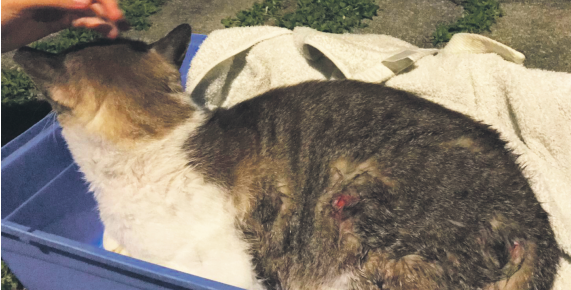Two campus cats killed this year spark safety concerns
13 Aug 2019
By Rexanne Yap
 Bobby succumbed to his injuries on 6 Apr, despite having undergone a surgery. He was one of two cats to have been viciously attacked this year. PHOTO COURTESY OF : CAT MANAGEMENT NETWORK
Bobby succumbed to his injuries on 6 Apr, despite having undergone a surgery. He was one of two cats to have been viciously attacked this year. PHOTO COURTESY OF : CAT MANAGEMENT NETWORK
In April this year, two of NTU’s popular campus cats, Bobby and Bushy, were killed by three stray dogs roaming around Halls of Residence 15 and 2 on 4 Apr and 21 Apr respectively.
The incidents have since sparked calls from students for these aggressive strays to be captured, for fear that they might strike again.
Eyewitness Chua Ru Xun, 24, had seen the three large-sized, skinny dogs a week before the attack on 5 Apr. One of them was black with white spots on its paws and the other two were a tan brown colour.
He had heard barking outside his dormitory window at 2 am on 4 Apr. To his horror, he saw one dog biting Bobby’s rear and another dog biting his hind leg when he looked out. He shouted at them, alerting passers-by and scaring the dogs away.
“Bobby was limping, traumatised and whimpering,” said the third-year student from the School of Physical and Mathematical Sciences, who then wrapped a towel around the cat and contacted the NTU Cat Management Network (CMN).
The members of CMN took the distressed cat to a 24-hour vet for surgery to remove dead hind leg muscles, cover an exposed sciatic nerve and treat more than 10 puncture wounds.
The bill came out to be more than 4,000 dollars, which was raised through community donations and profits from CMN’s past merchandise sales.
But even though he pulled through the operation, Bobby died of lung failure due to his injuries on 6 Apr.
Nur Qalishah Adanan, 22, the president of CMN, said: “Even if he was alive, he wouldn’t be able to walk properly as his back legs were paralysed.”
Since the incident, there have been at least three reports to CMN that stray dogs were prowling the campus late at night.
Qalishah added that the hostile strays could pose a threat to residents too.
“I get very scared when I see these stray dogs because I can’t anticipate what they might do. They might chase after me, they might bite me, I have no idea.”
Amanda Leo, 20, a resident of Hall 15, wants the dogs removed immediately.
“I’ve seen the dogs before the incident. One brown one was sitting outside Canteen 14. They seem dangerous because they are quite big,” said the first-year student from Wee Kim Wee School of Communication and information.
Dog trappings
To deal with campus strays, the NTU Animal Lovers’ Society (ALS) and CMN are working together to locate the dogs and get professionals to trap them.
Previously, these two groups had caught two light brown dogs themselves, but it turned out that they were not the aggressive ones they were looking for.
The costs of boarding the trapped dogs had been heavily borne by CMN's faculty advisor as well as by the fundraising efforts of CMN and ALS. After their rehabilitation stint, both dogs were subsequently rehomed, said Joyce Pek, 24, the alumna who captured the dogs.
But ALS and CMN have since stopped their members from performing dog trappings as they are not trained for potentially dangerous situations. They decided to pay for professional trappers and dog shelters for the new trappings instead. The Animal and Veterinary Service can then step in once the dogs have been trapped.
CMN and ALS said that they would not have enough funds to board the dogs even if they had trapped them. They urge NTU to step in to ensure the safety of residents.
Professor Victor Yeo, Deputy Associate Provost (Student Life), said that the University has received feedback about the feral dogs and has since engaged a professional dog catcher to round them up.
Qalishah hopes that the matter would be resolved quickly.
“We have to foster our cats indoors, but it’s impossible to keep them in halls forever. Until the dogs are trapped, we are constantly on high alert,” she said.


